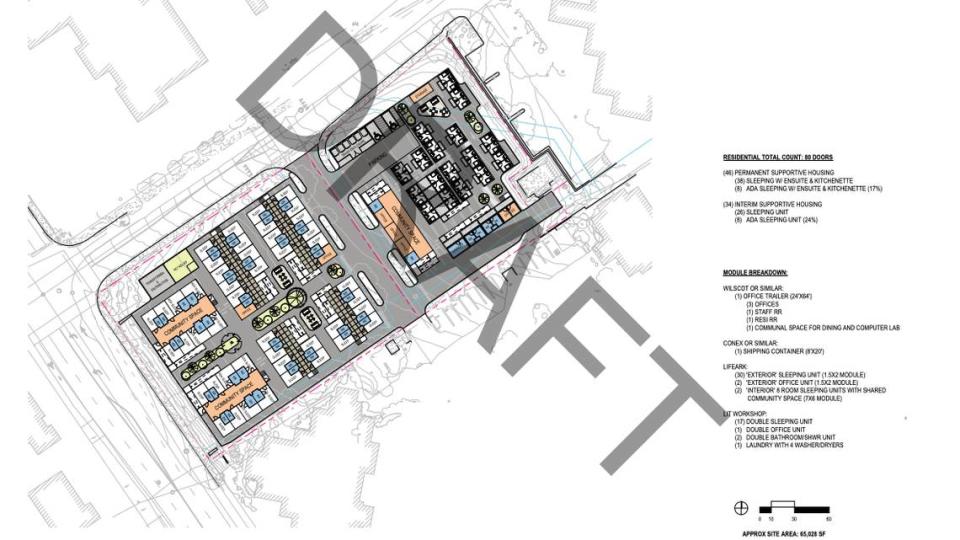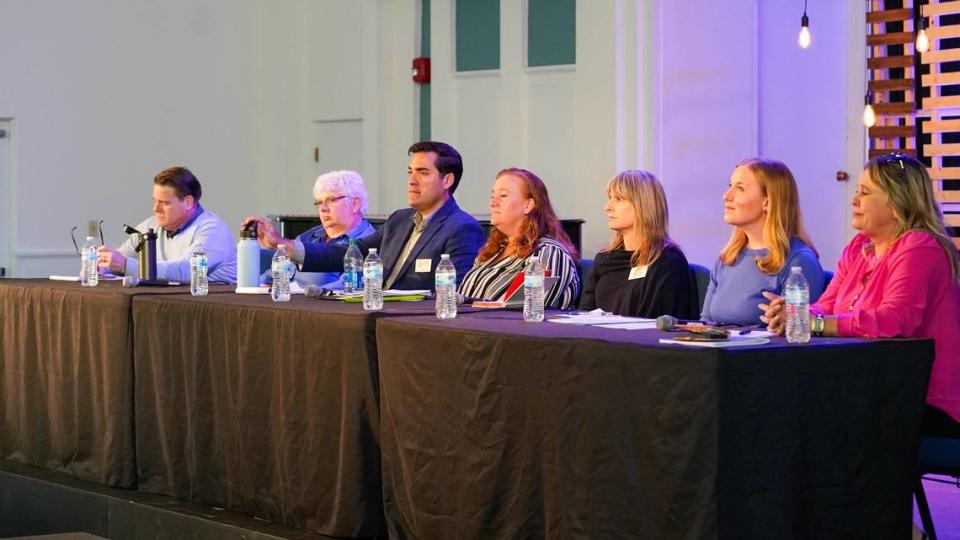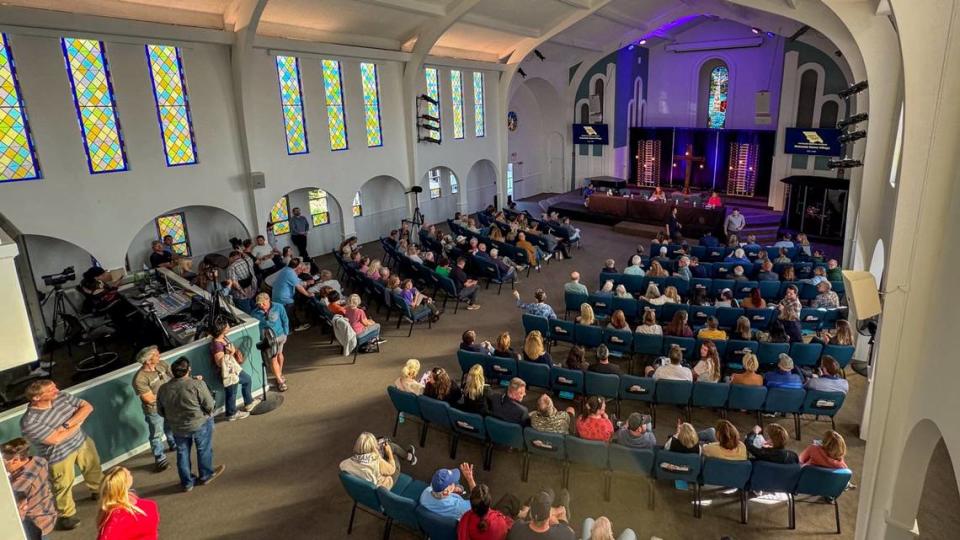Residents fear SLO cabin village will harm their neighborhood. Are their concerns warranted?
An 80-unit cabin village in San Luis Obispo that would help homeless residents transition into permanent housing has drawn backlash from neighbors, who fear a range of damaging impacts to their neighborhood.
But how founded are their claims?
San Luis Obispo County’s Welcome Home Village project is slated to appear before the Board of Supervisors on Tuesday, where residents of the nearby neighborhoods intend to voice their opposition to the project planned at Johnson Avenue and Bishop Street.
It’s hardly the first time that a transitional homeless project intended for a residential neighborhood has faced objections from neighbors.
Just last year, the city of San Luis Obispo’s plans for a rotating overnight safe parking program ground to a halt after residents voiced concerns about the project’s impact on the health and safety of the surrounding neighborhood.
The project has already been delayed and relocated once from its original proposed location at the county Department of Social Services lot at the corner of South Higuera Street and Prado Road after a combination of zoning issues and nearby business and resident backlash delayed the project for several months.
Now, the relocated project faces similar opposition, with a group of residents claiming in a May 15 statement to media that the county is fast-tracking the project and ignoring questions about “drug use, curfew regulations, parking, flood risk, fire risk, water use, sanitation, density, the safety of this often-used corridor, fiscal sustainability, environmental issues, zoning, and efficacy,” neighbors said in an email statement.
The issue has proven contentious within the neighborhood, with neighbors in opposition planning and subsequently canceling a rally about the project for March 18 after a counter-protest was announced using flyers in the neighborhood.
But what does the data — and track record of existing projects similar in size and goals to the Welcome Home Village — have to say about neighbors’ concerns?
The Tribune took a look at the dispute as part of its Reality Check series.

Why are residents concerned about the project?
Since the Board of Supervisors accepted a $13.4 million state Encampment Resolution Fund grant in July 2023, the Welcome Home Village has undergone several changes, with the biggest being its move across town.
At public comment and in their statement, neighbors have repeatedly asked the county why a residential neighborhood was the right fit for a project of this kind.
Originally, the site was considered for the county Department of Social Services lot on the end of Higuera Street and Prado Road, but switched to its current location because that site conflicted with both the city’s 1997 Specific Plan for the Higuera Commerce Park and the county’s Airport Land Use Plan, according to county homeless services division communications manager Suzie Freeman.
In the statement, neighbors claimed the move was made because of “legal action from a group of residents and business owners,” but Freeman said the county has not seen any legal action around the previous location.
Cabin village to provide shelter for 80 homeless residents in SLO. Here’s the plan
Freeman said the county considered four eligible project sites in San Luis Obispo that met the criteria of being near an encampment and settled on the Bishop Street location due to its access to multiple county and private medical practices, including Medi-Cal services at the San Luis Obispo County Health Agency and several providers within the Bishop Medical Center.
In the statement, residents also took issue with the relatively short month-long lead-up between the initial announcement of the site on April 16 and the community meeting in early May, but Freeman said the county could have elected to move forward without noticing neighbors at all.
“For this project at this location, there was no notification requirement,” Freeman said in an email. “All community outreach done by either the county or the project partners has been elective.”
Why pick a residential neighborhood?
In its current location, the site would be developed by DignityMoves and managed by Santa Maria’s Good Samaritan Shelter, which currently maintains 500 supportive housing units in Santa Barbara County.
By comparison, the Welcome Home Village dwarfs the pair of 20- and 30-unit cabin programs built by DignityMoves in collaboration with the 5Cities Homeless Coalition in Grover Beach, which some residents objected to at the community meeting.
The developer currently operates in seven California communities, including three villages opened in Santa Barbara County in recent years, Freeman said
A larger, 94-unit DignityMoves project opened in March, and another 80-unit project debuted in April, according to the organization’s website.
DignityMoves said its methods have proved effective enough to warrant an agreement with the Santa Barbara County Board of Supervisors to add 300 more rooms of interim housing to fill the county’s gap.
By comparison, at the community meeting in San Luis Obispo, Freeman said the county’s 2021 assessment of homeless needs indicate a shortage of around 300 more interim shelter beds to reach a capacity of 525, and said there are only 245 such beds in the county when accounting for all Community Action Partnership of San Luis Obispo, El Camino Homeless Organization and 5CHC beds.
Neighbors have criticized the project’s proximity to residential homes, parks and commonly used paths between nearby schools such as Sinsheimer Elementary. Some residents also said the project doesn’t fall within its intended use of being placed near an encampment — in this case the Bob Jones Trail — which is around two miles from the village on the other side of town.
In fast-tracking Welcome Home Village project, SLO County doesn’t play fair | Opinion
In public agenda correspondence to the Board of Supervisors, residents Christa and Kevin King said the project is being pushed through the approval process by meeting the specific criteria of the Encampment Resolution Fund grant attached to the project.
“The lack of time for input feels (to the community) like an attempt to thwart public participation,” the Kinds said in a letter to the board. “Due process and public comment are being short-circuited.”
“The rushed process means that no meaningful discussion has occurred about other locations that may be better for the unhoused population.”
Resident Kelda Wilson said in agenda correspondence the project does not scale well with existing transitional housing projects such as Cabins for Change, and said she was worried it would make the neighborhood more dangerous.
“My kids play in the Sinsheimer neighborhood regularly, and I have concerns about what changes this project could have that would impact their ability to use the area the way they do,” she said. “There are much better locations within SLO for the Welcome Home Village, and it is prudent that those be figured out and the project scaled proportionately to that location.”
Freeman said despite the distance from the encampments, the project still conforms with the grant requirements.
“The integration of the Welcome Home Village into the county Health Campus was an opportunity to add supportive housing services to the community resources already offered at this location,” Freeman said in an email. “The project’s proximity to outpatient behavioral health services, the sobering center, and other county services also promotes timely and convenient access for those living at the Welcome Home Village who may need those services as part of their case plan.”

Should residents have concerns about who will live at the project?
In emails shared with The Tribune, multiple neighbors said they believed drug use and crime would rise in their neighborhood if the village was allowed to open.
Neighbors said they’re also concerned about fire risk and whether the project and its residents will impact the value of property in the area.
Freeman said the county will work with the San Luis Obispo Fire Department and Cal Fire to ensure that the project fully meets fire code.
She also said the village will operate under a zero-tolerance drug and alcohol policy, meaning clients found using banned substances will immediately be referred to an off-site substance abuse disorder treatment facility.
At a site of comparable size in downtown Santa Barbara, 25% of clients have used services related to substance abuse disorder treatment, Freeman said.
Cabin village proposed on Johnson Avenue gets mixed reaction from SLO neighbors
When the county originally applied its Encampment Resolution Fund grant in early 2023, two similar interim supportive projects — the 20-unit Cabins for Change project in Grover Beach and a 34-unit project in downtown Santa Barbara — were used as benchmarks for setting program expectations.
Those two programs have graduated around 70% of their clients into stable housing, Freeman said.
Since then, more village-style tiny homes at a similar size to the Welcome Home Village have opened on the Central Coast, Freeman said.
She also cited a 2020 study from the Health Services Research journal that analyzed the outcomes of Santa Clara County’s 130 units of permanent supportive housing as a potential goal for the Welcome Home Village.
“By providing people considered to be high-users of publicly funded services with access to subsidized housing with integrated case management, 86.4% of program enrollees became housed and 169 of the 172 program enrollees were able to maintain housing for the 28 month follow-up period,” the study read. “In comparison, only 36.2% of those in the study who received “usual care” entered housing.”

Can organized backlash kill projects?
The Welcome Home Village is far from the only project in recent years to face community backlash that has threatened to derail or doom it entirely.
Last year, the city of San Luis Obispo’s two proposed locations for a rotating overnight safe parking program drew sharp criticism from neighbors of the program’s planned sites at Palm Street and SLO Naz Church.
Since the most recent community meeting on that project — attended by around 200 people who largely opposed the project in their neighborhood — no further updates have been given by the city on the rotating program.
With one delay already behind it, the Welcome Home Village’s clock is ticking. The project must spend 50% of its grant funds by June 30, Freeman said.
Krista Jeffries, lead organizer of SLO County YIMBY, said its not uncommon for developments of every type — from transitional homelessness projects like the Welcome Home Village to traditional housing projects — to fail because of vocal arguments that aren’t always founded in fact.
“Just asking questions” is something that always sounds innocuous, reasonable, and expected from intelligent people, she said. In their desire to curry as much public support as possible for controversial projects like this one, staff and elected officials will often provide as many public meetings as possible, both official and unofficial, in the hopes that everyone will have their questions answered, with the hope that they will move from opponent to supporter.
She said in this process, its not uncommon for people who oppose a project to argue in bad faith in an attempt to wear the project down by attrition, by continuing to raise concerns and claim they are “just asking questions” about the data on which the project is based, even when evidence-based answers have already been provided.
“When it comes time for the rubber to meet the road on a project, opponents still claim that their questions have not been answered, when they have,” Jeffries said. “They just haven’t been given answers that they like.”
Resident Patricia Frey expressed a similar opinion in public agenda correspondence.
“Too often, we are so certain that as laypersons we ‘know the right way’ to address homelessness, that we refuse to listen to the experts who spend their professional lives doing just that,” Frey said. “They are the ones who have spent years studying the dynamics leading to homelessness, and they are the ones who have the expertise that create successful solutions.”
Jeffries said the moment is not coming in which community members will feel their questions or concerns have been satisfied to the point where the project can go forward with their support.
“Ultimately, I don’t believe it is a good exercise of democracy to give current residents veto power over who moves in after them,” Jeffries said in an email. “None of my neighbors demanded my psychological or criminal history when we bought our house. We just handed the bank a check and moved in. But somehow, once somebody has been described as categorically poor, they have to be scrutinized within an inch of their life before they can find safe shelter in one of the wealthiest states in the wealthiest country in the world.”
What’s next?
There are still outstanding questions about how the project will be maintained long-term, with operational costs expected to cost $1.84 million per year.
The county has yet to allocate funds for this continued cost, which could continue for a minimum of 20 years if the 80 climate-controlled cabin units last as long as advertised, Freeman said.
The project’s design is also not finalized, with several specific details of the project site yet to be completed.
“The Welcome Home Village has completed the preliminary site design and test fit to confirm the project’s feasibility at the location,” Freeman said. “Assuming the project location and funding to the developer are approved by the Board of Supervisors, then the more detailed site planning work can begin.”
The San Luis Obispo County Board of Supervisors will hold a final approval hearing for the project Tuesday.


